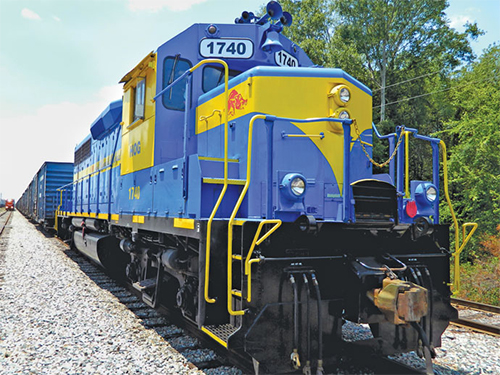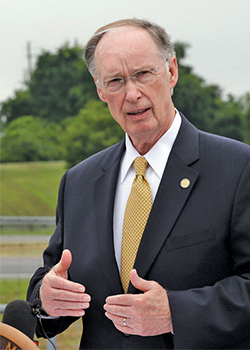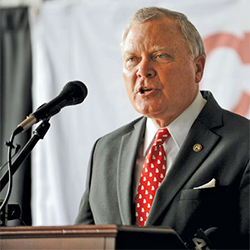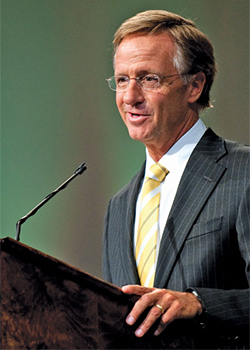“Push the infrastructure,” said Scott Condra, president of Jacoby Development, during a panel discussion at Brownfields 2013 in Atlanta this summer. “That’s where the private developers are going to be interested in investing.”
The Jacoby team ought to know, having pursued the successful redevelopment of a steel mill into the mixed-use Atlantic Station, next to a downtown Atlanta Interstate where half a million cars a day go by. More recent is Jacoby’s successful involvement in the purchase and redevelopment of the Ford Motor Co. site near Hartsfield-Jackson International Airport and multiple Interstates, where Porsche chose to locate a $200-million North American headquarters and testing center.
A lot of people questioned whether Porsche would commit, said Condra, but Atlanta Mayor Kasim Reed and Georgia Gov. Nathan Deal worked with the company to put together a framework. Crucial to that framework was the airport’s just-completed $1.4-billion Maynard H. Jackson Jr. International Terminal, which he called “critically close” to the proposed Porsche site.
“Demographics will change,” said Condra. So will elected officials, real estate markets and the price of milk. What is critical, he said, is the infrastructure: “That infrastructure made us [and Porsche] feel good about investing in that site.”

In July 2013 the Georgia Ports Authority signed an agreement that will link Cordele Inland Port by rail with the Garden City Terminal in Savannah. “This vital link will reduce truck traffic in and out of Savannah,” says Georgia Gov. Nathan Deal, “and allow our port customers to access new industries including agriculture and timber in that area.”
Image courtesy of Georgia Ports Authority
Walter Mercer, executive vice president and head of the commercial real estate line of business for SunTrust Banks, agrees. When he looks at the Southeast, he thinks of the watershed moment in late 2011 when, for the first time, more shipping containers were coming into the East Coast than the West Coast.
“Infrastructure is critical to attracting companies,” he says, and the Southeast “is in the middle of some of the largest changes since World War II in real estate and infrastructure.”
Site Selection studied current infrastructure issues across the Southeastern US states of Alabama, Florida, Georgia, Mississippi, North Carolina, South Carolina and Tennessee. We then sent three questions specific to those issues to the governors in each state.
Some of them replied. Some did not. Either way, below we present the policies, programs and projects that amount to their answers.
Alabama

Alabama Gov. Robert Bentley talks with reporters in Calera, Ala., in July as he announces another $372 million in road and bridge projects for 45 counties in Alabama. A $10-million bridge-widening project in Calera bring Bentley’s Alabama Transportation Rehabilitation and Improvement Program to nearly $1 billion in projects.
Photo by Jamie Martin courtesy of Governor’s Office
In April Gov. Robert Bentley signed into law a measure that will help more counties participate in the largest road and bridge improvement program in Alabama’s history. The bill established the Rural Assistance Match Program (RAMP), available to counties that are unable to meet the 20-percent local funding match required to participate in ATRIP, the Alabama Transportation Rehabilitation and Improvement Program. ATRIP was established by Governor Bentley in 2012 to help local areas access funding needed for essential road and bridge improvements. By May, 254 road and bridge projects were moving forward thanks to RAMP.
ATRIP is expected to distribute up to $1 billion in federal funds during a three-year period for eligible projects submitted by participating counties and cities throughout Alabama. The ATRIP funds will be provided up front by GARVEE bonds and repaid by future federal highway funding appropriations.
“ATRIP is making a difference in every county across the state by allowing much-needed road and bridge improvement projects to move forward,” writes Gov. Bentley. “As we make these improvements, we’re improving public safety, and we’re also helping attract more jobs. When companies look for places to build and expand and hire more people, they look for places that have good roads and bridges. Our roads and bridges will be much safer thanks to this program, and our communities will be in a better position to recruit more jobs.”
Exports are a strong priority for Bentley’s Accelerate Alabama plan. Asked which projects are going to help push exports even further than the record $19.5 billion in value achieved in 2012, Bentley writes, “Alabama’s infrastructure has a direct impact on our global competitiveness. It is critical because state-of-the-art transportation, maritime transport, telecommunications and energy networks (electricity infrastructure) are what moves goods, ideas and workers efficiently.” He says in addition to the ATRIP program, “the Port of Mobile and Port of Huntsville are set to take on increased cargo to help export goods.”
In 2012, companies announced 20,847 new jobs and more than $5.4 billion in investment coming to Alabama.
Asked what his administration is doing to increase the availability of broadband, he says, “The Administration is currently considering options to increase the availability of broadband infrastructure to residents, communities and businesses throughout the state by utilizing federal resources currently available. In the meantime, we are working with specific grantees to ensure necessary mapping of the entire state is up-to-date. The mapping includes specific data collection received from community anchor institutions.”
Florida
The Florida governor’s office did not respond to Site Selection’s three questions by deadline. But Gov. Rick Scott’s policies and pronouncements speak volumes, as do other actions by other parties seeking to undergird the state’s economic development progress.
Scott’s proposed budget earlier this year included substantial investments across all modes of transport, including the state’s 15 seaports. And this summer he signed into law HB 85 to standardize a framework for local public-private partnerships to facilitate public-purpose project construction.
Gov. Scott’s “Florida Families First” budget was signed into law in May.
“Florida’s infrastructure is ranked the best in the nation by the U.S. Chamber of Commerce Foundation,” said Scott. “The Florida Families First budget will help ensure we stay number one by fully funding the Department of Transportation’s Work Program, including projects to maintain and improve our roads and bridges. The budget also includes more than $278 million for development and enhancement of our seaports. We must build on the work we’ve started at our seaports to prepare for the post-Panama Canal expansion which will support job creation.”
“With Florida ports now making up 13 percent of Florida’s GDP, the numbers prove that the state’s investment in port infrastructure is working to grow our economy and jobs,” said Florida Ports Council President Doug Wheeler.
At press time Scott announced the $39.9-million South Florida Logistics Center would receive a $2.5-million grant from the Florida DOT. Other projects benefiting from the state’s Intermodal Logistics Center Infrastructure Support Program include the Keystone ILC Terminal (Jacksonville), the Port of Panama City Intermodal Distribution Center and the Port Manatee Commerce Center.
Georgia
The results of summer 2012 voting for a special-purpose local option sales tax for transportation surprised some Atlanta-area supporters who thought it was a sure thing, given the area’s congestion problems. But unknown to many outside the state was the fact that a swath of middle Georgia communities approved the measure. We asked Gov. Nathan Deal how those results are moving projects forward.
“The July 2012 Transportation Investment Act (TIA) vote and approval by residents in three regions in middle Georgia will ultimately deliver 871 transportation-related projects with an investment of $1.4 billion over the 10-year tax period to those communities,” says Gov. Deal. “An additional $400 million in collections will be distributed directly to local governments throughout the regions for use on any transportation-related projects in the communities. Although tax collections just began six months ago, numerous projects are already under way and some are actually completed,” he writes. “Construction lettings over the next six months will begin many more TIA projects to the citizens who approved the transportation referenda.”

Georgia Gov. Nathan Deal
The largest completed project, he explains, is the installation of dedicated turn lanes in Toombs County on SR 130 allowing a new manufacturing facility to open operations and employ hundreds of local citizens. “The economic development benefits of this project will be felt for years to come,” says Gov. Deal. “Additionally, there are 30 resurfacing projects scheduled to begin within the next month as well as a major widening to four-lane the last segment of US 27 between Columbus and the Florida state line. Some of the larger municipalities are currently working to deliver their own projects at an accelerated rate. Local governments in many locations have been actively utilizing their 25-percent discretionary share of the revenues to deliver projects including sidewalks, a roundabout and safety enhancements.”
As the inland port in Cordele further solidifies Savannah/Brunswick as a port investment destination, we asked Gov. Deal to share his perspective on what rail infrastructure means to the state.
“We are working hard to expand and enhance our role as the economic gateway to the Eastern Seaboard,” he said, reminding us of Georgia’s 5,000 miles of freight rail track that run through most of its 159 counties, transporting more than 80 million gross tons a year. “Georgia stands committed to Freight Rail Transportation and will continue to work with private railroad companies, state and local governments to preserve and expand freight railroad services in Georgia.”
Mississippi
A legislative task force assigned the duty of surveying the state’s highway needs is expected to file a report in time for the 2014 legislative session. Chief among its challenges, according to a July Associated Press report, is how to fund needed road and bridge maintenance even as the fuel sales tax (one of the lowest in the nation) sees its pool of money dwindle due to more fuel-efficient vehicles on the road.
One of the big pieces of Bryant’s package of energy-related measures signed into law in May was a new revolving loan fund for energy infrastructure, giving communities the ability to help finance energy infrastructure (for instance, gas lines and transmission lines) for companies that invest more than $50 million in an economic development project. In the same package was a measure exempting sales tax on energy used in manufacturing.
Say “infrastructure” and most people think of highways and bridges, but they may not think of work force health. Gov. Bryant is seeking to change that with a new Healthcare Solutions Institute and other health-related policies tied to economic development and project attraction from the private sector.
North Carolina
One of North Carolina’s big-city leaders now is fielding infrastructure questions from the entire nation: Charlotte Mayor Anthony Foxx was nominated in the spring to serve as US Secretary of Transportation, and sworn in in early July.
During Foxx’s tenure from 2009 to now, investments in Charlotte included extending the LYNX light rail system; expanding Charlotte-Douglas International Airport; working with former North Carolina Gov. Beverly Perdue to accelerate the I-485 outer belt loop using a creative design-build-finance approach; and starting the Charlotte Streetcar project.
North Carolina Gov. Pat McCrory in his State of the State address early this year presented a holistic view of infrastructure, incorporating such categories as water and educational institutions. McCrory said the four key infrastructure areas his administration would focus on would be transportation, water, energy and communications.
North Carolina has the nation’s largest state-owned highway system (80,200 miles).
McCrory’s administration has put forward a concept called the Strategic Mobility Fund, which was part of the $20.6-billion budget he signed into law in July. McCrory said this piece of transportation reform will “connect rural areas to the state’s economic centers. Population will also factor in more prominently into the location of future transportation infrastructure projects.”
South Carolina
Gov. Nikki Haley in June signed a landmark infrastructure bill June that establishes an infrastructure pool to leverage borrowing. It includes $50 million in recurring funds allocated to the State Infrastructure Bank (SIB) to be bonded for $500 million. The package also includes moving half of the sales tax on automobiles to the Highway Fund on a recurring basis, generating about $41 million annually. Additionally, $50 million in one-time funds will be used for bridge repairs.
South Carolina had not seen a significant funding increase for roads and bridges since 1987, when there were 1 million fewer residents living in the state. Last year state DOT official said the state would be $29 billion in the hole as it faced a projected need for $48.3 billion of road repairs over the next 20 years.
A June report from the U.S. Department of Commerce’s Bureau of Economic Analysis ranked South Carolina’s economy as the 12th fastest growing in the nation, and tied with North Carolina as the fastest growing state on the East Coast. South Carolina also had the fastest growing manufacturing GDP on the East Coast.
Tennessee
The Volunteer State earned praise recently for its transportation infrastructure from CNBC, ranking second in the nation in that category. What has Gov. Bill Haslam’s administration done to help the state get to that point?
“Soon after taking office, I asked each department to conduct a top-to-bottom review to make sure we were focusing on our core missions and doing so in the most efficient and effective way possible,” Gov. Haslam tells us. “As a result, we restructured the Department of Transportation (TDOT) to run more efficiently by taking an asset-management approach when determining the best investments in the state’s transportation network. TDOT consistently wins national awards for high-quality and innovative transportation projects. TDOT’s focus on maintaining a high-quality Interstate system also receives national recognition.” The state DOT also happens to be the only top-rating state in CNBC’s ranking that carries no debt.

Tennessee Gov. Bill Haslam
Asked for his perspective on the back-and-forth with Georgia over the Peach State’s wishes to obtain water from the Tennessee River, Gov. Haslam says, “I have a good working relationship with Gov. Deal. Tennessee is comfortable with where the border is now. I don’t spend a lot of time on this issue.”
Site Selection readers are familiar with the gamble on interchange investment that the state took prior to the VW announcement of its $1-billion, 2,000-worker plant in Chattanooga. A May 2013 report from the University of Tennessee’s Center for Business & Economic Research found that as of 2012, Volkswagen had added an additional 415 direct jobs and helped attract 17 supplier companies to the area. “In total,” the report state, “we estimate that the Volkswagen assembly plant will increase state revenues by $31.2 million annually and local revenues by $22.3 million each year.”
“During the past 12 months, 12 state industrial access road projects have entered the construction phase with a combined cost of $17,870,677,” Haslam says. “These are supporting new and/or expanding industries making capital investments in Tennessee totaling $1,313,031,500 that are creating 2,266 jobs.”
